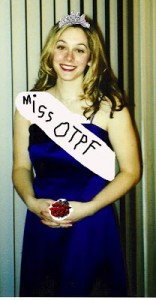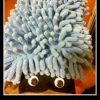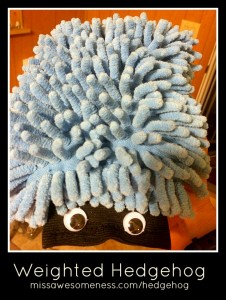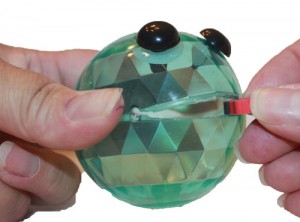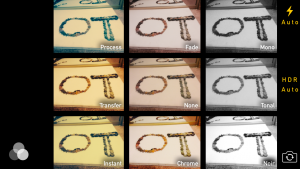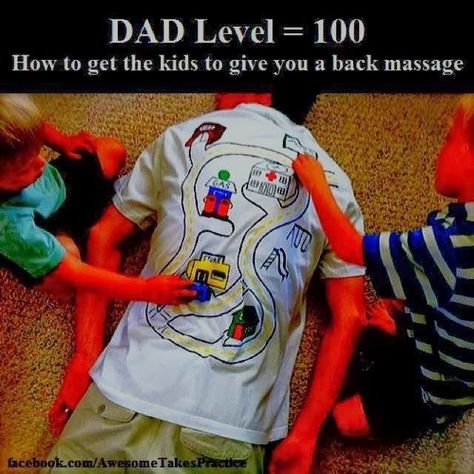Occupational Therapy
The Life Lemonade Resume: Making those Lemons Palatable
What makes you, you? We all have our unique stories, our life of accumulated events that define us. Sometimes it’s hard to look on the bright side when life hands us lemons, especially when Life shops at Costco. I’ve kept a “life resume” for years, and many of its entries come from life-lemonade events.
For example, have you…Ruined an iron by permanently branding it with a platypus?
Saved a dying angelfish in your aquarium using only a long breadstick?
Been followed home by a former client in an airplane?
Been burned by a crystal ball?
Broken your toe on a rock while hula hoop dancing at the beach? [Just happened last week. Ow.]
Given yourself a black eye with an ice cream scoop?
Nearly strangled yourself to death with hula hoops in a parked car?
Been bruised by a gallon of green juice bouncing off your shin?
No? Because I have. Stories like this make me “me,” they give me my occupational identity. When that gallon of juice bounces off my shin, my first thought is OW, that sucked. But my second thought is haha, another entry for my life resume. Bet not many other people can say juice bounced off their shin. Another “this is the unique story of Karen” moment.
Think about yourself, think about your clients. Do you have any that can see the humor or uniqueness in their stories, especially the smaller, day-to-day ones? Do you think you could compile your own life resume? You can make one that includes all the life basics – places you’ve been, people you’ve met, special events, pets, scars, etc. Add in life lemonade – and life awesome-ade – as it comes! It can be little – if you get creative, you could probably have daily entries.
With this reflective approach, we “aid” our lemon events in becoming more palatable. We recognize that each event is a contributor to our unique occupational identity, rather than a detractor. And we can laugh about a lot of them! Laughter is the most natural sweetener there is…truly a way to make lemonade.
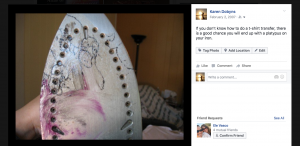
Framework-III for OT Students/Practitioners, Cheatsheet
The newly updated Occupational Therapy Practice Framework: Domain and process, 3rd edition, otherwise known as the Framework-III is an important document provided by the American Occupational Therapy Association, and all therapists and students should be intimately familiar with it. Figuratively. Only figuratively. I have slept with it though. Literally, in OT school, I fell asleep with the first edition more than once. That’s why they called me Miss OTPF. We had a Miss OTPF pageant too, but the opposite of occupation-based in true parody style! Anyway. Moving on. Now that I am back in school for my post-professional clinical doctorate in occupational therapy (OTD), the Framework-III and I are once again sharing a pillow, and I’m putting my crown back on, deserved or not.
The true framework is quite long, so this just gives you a cheatsheet taste of categories/terminology. Here’s a 1- page PDF of this outline of the Framework-III. FrameworkOutline.pdf
Occupational Therapy Practice Framework: Domain and Process, 3rd ed., (abbreviated/referred to as Framework-III)
An official document provided by AOTA, summarizing occupational therapy’s unique approach to healthcare. Our domain focuses on “achieving health, well-being, and participation in life through engagement in occupation,” through a vision of “occupation based, client centered, contextual, and evidence based” care.
OTs must evaluate a client holistically and deductively with an “occupational profile”, using below categories as guidelines, before determining intervention approach.
Clients can refer to persons, groups, and populations [newly expanded definition]
Occupations (meaningful life activities that clients engage in)
- Activities of Daily Living (ADL) – (personal hygiene, bathing, sexual activity, etc.)
- Instrumental Activities of Daily Living (IADL) (care of others, community mobility, financial management, shopping, safety, etc.)
- Rest and Sleep, Education, Work, Play, Leisure, and Social Participation
Client Factors (reside within client and influence client’s performance in occupations)
- Body Functions, Body Structures, Values, beliefs, and spirituality
Performance Skills (observable actions with a functional purpose)
- Motor skills (observed physical interactions, i.e. reaching, bending, manipulating)
- Process skills (observed “executive functioning” during a task, i.e. initiating, sequencing, gathering, problem-solving)
- Social interaction skills (observed during social interactions, i.e. transitions, gesticulations)
Performance patterns (behaviors related to activities of daily life)
- Habits, Routines, Rituals, Roles
Context (environmental conditions that may affect client’s performance)
- Cultural, personal, physical, social, temporal, virtual
*Please see reference for comprehensive details in each area. Use this brief handout at your own risk!
Example of citation in-text: We used the Occupational Therapy Practice Framework: Domain and Process, 3rd ed., ([Framework-III], AOTA, 2014) for our project. The Framework-III (AOTA, 2014) is awesome.
Reference: American Occupational Therapy Association. (2014). Occupational therapy practice framework: Domain and process (3rd ed.). American Journal of Occupational Therapy, 68(Suppl. 1), S1-S48.
Weighted Hedgehog: OT Sensory Tool
This weighted hedgehog is so simple to make. A sensory tool you can make extremely quickly and for less than $10.
Materials:
1. Car-wash-mitten (often found in CVS $1-4 section or dollar store).
2. Eyeballs (If the sleeve isn’t black, you can Sharpie them).
3. Beans/rice/whatever weighted item you want, double-zipped in high-quality zip-lock.
How to Make:
1. Stick the ziplocked weighted material into the mitten.
2. Put on eyeballs!
3. Sew shut the mouth, or if you are sewing-challenged like me, I first used velcro until a friend helped me out. It only takes a minute or two.
Uses:
Have the hedgehog sit on their laps or by their side. Stroke the textured surface and feel the (mild) calming weight. I can see this being nice for a child who is resting and wanting to touch something. It’s a sensory tool, tactile with texture and proprioceptive with weight.
You could probably also throw it as a form of ball with older children who can handle weight being thrown, to make it more sensory-motor!
*It can be a choking hazard if taken apart, or potential suffocation hazard. Please supervise if used with younger children.
Want to print it/download the PDF of this? Weighted Hedgehog Making
OT Invention Munchy Balls: Fine Motor/Sensory Motor Play
Occupational Therapist Tonya of TherapyFunZone.com invented this awesome toy. You can check it out here and buy it in her online store.She has quite a few posts with ideas on how to use it, including messy sensory play and kinetic sand. I also included a few pictures of it being naughty. 🙂 I’ve played with it myself (cough) and with my OT kids, and it’s a hit. Very similar to tennis ball head, but A) pre-made so you don’t lose fingers, and B) Waterproof/nicer material.
Oh, and when you buy it? She has all sorts of digital downloads (including my lava paper for $1) and other fun games, super cheap. I know this sounds like an advertisement, but it’s more trying to share great resources by great OT. I recommend this parents, schools, and pediatric occupational therapists.
OT Lifehack: No more hook marks on your softer clothes
I dislike how softer fabrics get pinched marks in their clothes if left on a hook. I drape my sweaters over instead, but it takes up a lot of space. I realized that my little pediatric “tennis ball head” for kids, with the slit in it for a mouth, could help me out! Check out the picture…
Now, I don’t know if lint will be an issue yet, but you could always buy this vinyl version (Munchy Ball), pre-made, from TherapyFunZone to avoid that issue.
Hyperchange Curriculum for Occupational Therapy Students
In an Utopian OT world, there would be a weekly 3-hour course that spanned the duration of an occupational therapy student’s career in their master or doctorate OT program. It would primarily consist of guest speakers from other disciplines or expert OTs. Many would require real-world assignments. The curriculum would be extraordinarily interdisciplinary, cutting edge, relevant, and innovative, with a focus on what OT Jim Hinojosa addressed as “hyperchange” in his 2007 Slagle lecture. He discusses how OT student curriculums need to evolve so they better address “how” to learn, rather than “what”, with emphasis on flexible thinking, problem-solving, creativity, efficiency, and a much more interdisciplinary focus. Students would be equipped with cognitive tools to navigate the future, and learn how to access the information they need when in a constantly changing environment. He notes today’s students have spent their entire lives in a hyperchange environment, and are best suited to the challenges we face ahead in this area. Here are some of my (idealistic) class ideas.
- Legalities and Liabilities of Innovative Practice (lawyer)
- Fundraising, Grant Writing, Finding Sponsors/Volunteers (expert)
- Entrepreneurialism, Marketing/Branding in Changing Healthcare world (marketer, designer)
- Keeping Occupations Intact in Face of Productivity/Budget Challenges (OT)
- Awareness of Eastern Medicine/Naturopaths/Alternative Healing (healer)
- Interdisciplinary Relations: Collaboration and Creation (multi-disciplinary panels)
- Healing Touch and Energetic/Touch Modalities (practitioner)
- Inventions/Product Design, How To (experienced inventor)
- Perspectives of client and therapists in mental Health OT (client, mental health OT)
- Perspectives of client and therapists in OT Emerging Practice Areas (panel of OTs and clients of differing areas)
- Flexible-Thinking and Problem-Solving (cognitive psych? hmm)
- Perspectives of OT from Other Disciplines (panel)
- Creative Use of Thrift Store/Dollar Store Materials
- Creating Something out of Nothing: Ninja OT with limited access to materials
- Psychology of Persuasion, Motivation, Hope (specialized psychologist)
- Psychology of Trauma/Grief: Reflective Listening and Clinical Communication Skills (specialized psychologist)
- Psychology of Illusions and Conmen: Skillfully using psychological techniques of distraction, expectation, and perspectives to approach challenging OT sessions (guest performance pickpocketer or similar – see bottom for details – not to be used in a manipulative way but rather helpful).
- Lots more ideas!
I know my program (I graduated in 2009) addressed some of these, and I hope and imagine many current programs are addressing this via prerequisites or within the program itself. I’d love to hear what other OTs would like addressed, or what educators are already starting to address. I’m currently in a post-professional OTD program, so I’m thinking a lot about education!
——–
Bonus: I highly recommend you look at the youtube video and article on the following two real-life characters: Apollo Robbins is a famed (performance) pickpocket who uses the victim’s expectations and distraction against him: http://www.newyorker.com/magazine/2013/01/07/a-pickpockets-tale for the article
This 6-minute video amazed me – he was able to pickpocket the victim even though the victim KNEW Apollo was about to try, and when you watch it assuming you will be able to tell, you can’t. Shocking.
Frank Abagnale was a conman made famous by the movie Catch Me if you Can, although I prefer his autobiography. http://en.wikipedia.org/wiki/Catch_Me_If_You_Can. He was able to successfully impersonate a pilot and doctor and other highly skilled professions, as well as start a new type of check forgery, by the time he was 19. He did a stint in jail, but ultimately ended up working for the FBI in their check fraud department, because he knew better than any non-criminal how to do it! He also used distractions, expectations, perspectives of other, and illusion, as his methods for success.
Playful Pediatric Car Activities Using Road Clothes!
Found this silly picture with the dad wearing a road t-shirt and getting a “car massage” by his children. If you made a child some road pajamas (long-sleeved white shirt and pants and then drawn on with fabric Sharpies or the equivalent), you could do some great occupational therapy work.
Because this does involve “on-body” play, remember to be extremely careful about liability and consider only using this activity when parent is present, so that you can role model how to play at home, and ensure child is comfortable and able to express preferences.
Possible Activities:
PROPRIOCEPTION/TACTILE: Use cars of varying weights for lighter versus heavier touch as you narrate your path (…now we’re cruising along Right Leg Lane, looking for ducks…”) Super light touch: use your two fingers to “walk” as a pedestrian on the sidewalk Heavy touch: Use a heavy beanbag as a bull-dozer and “roll” it along its path
TACTILE: Make the path long and straight down both arms and both legs – if a child doesn’t normally like to put on long sleeves/pants, maybe he would if the car otherwise has to come to a screeching halt so soon on the journey.
STRENGTH: Make path circular around the legs and arms – make child lift up arms/legs for car to travel underneath “ooh your leg is soo heavy, my car is stuck, help!”
RANGE OF MOTION: The car can go down to the hand and and decide it wants to go to the other hand by having child raise both arms up 90 degrees and meeting at midline; the car may need other types of bridges from foot to hand and avoid the “body of water”
DIRECTIONS/ORIENTATION: Have child direct car or vice versa to go south/north/left/right/start at Right Arm Avenue etc
GRADATION OF MOVEMENTS: Have child practice on another child, or on your own long-sleeved shirt (or use washable marker on your arm only), of slow/fast/slower/faster
TURN-TAKING: Switch the car back and forth between the two children or you and child, potentially making a bridge, etc
BALANCE: Consider having the child stand up while the car drives!
More occupational therapy related pins here:
https://www.pinterest.com/funkist/ot-ideas
"I never worry about what they can't do…I worry about what they can do."
"They can’t move, they can’t be independent. They can’t live their lives," said Norton, 55. "I’m building them up, building them stronger, so they can go out and live life like they’re supposed to."
"I never worry about what they can’t do," said Norton. "I worry about what they can do, and make them as independent and capable as possible."
CNN Hero Ned Norton owns a gym and focuses on helping people with disabilities get into shape. Here are some quotes from this article which you can read at this link: http://www.cnn.com/2014/05/01/us/cnnheroes-norton/index.html?hpt=hp_t4
Seems to me he and his clients could benefit from a collaborative relationship with an OT. 🙂 Wonderful quotes and wonderful actions! Lovely story. He has the heart of an OT with his approach.
Magnetic Dry Erase Slant Boards
I really like their magnetic dry erase slant boards for children/adults who benefit from the slant, often due to visual or physical issues – the boards are thin and easy and awesome. I used it all the time, and am buying a new one as I had to give up my former one! They are currently $30 or cheaper if you buy more than 1, but they are going up to $33 starting January 1st.
I wanted to do a good review with lots of pictures and all, but sorry, for now, click on the link, see what you think. It’s straight forward. 🙂 So that you can get one as Christmas presents or before the new pricing goes into effect. I just wish the shipping were cheaper. They are in San Diego though so I am going to see if I can pick mine up.
Enjoy!
Developmentally enriching guide for toys and gifts, recommended by occupational therapists
The following occupational therapists (OT) have posted gift and toy guides that can help you navigate the overwhelming holiday decisions. These are all gifts that are developmentally appropriate and enriching while still being fun. Since OTs are writing them, many of the toys can be geared at children with special needs or varying levels of age/function. Enjoy!
Colleen, OT, at Sugar Aunts, blogged about toys and gifts to help with scissor skills and improving pencil grasps.
http://www.sugaraunts.com/2014/11/toys-to-help-with-scissors-skills-gift.html
http://www.sugaraunts.com/2013/11/gift-guide-toys-to-improve-pencil-grasp.html
Mama OT blogged about toys to help pencil grasp without using a pencil –
http://mamaot.com/2014/11/23/toys-and-games-to-help-kids-pencil-grasp-without-using-a-pencil/
Mama OT also blogged a PRINTABLE list of "Ultimate List of Gifts for Sensory Seekers"
http://mamaot.com/wp-content/uploads/2014/11/PRINTABLE-The-Ultimate-List-of-Gifts-for-Sensory-Seekers.pdf
Her original blog post about it was here.
http://mamaot.com/2013/11/29/ultimate-gift-list-for-sensory-seekers/
Meghan of Mac&Toys posted a MASSIVE holiday toy guide list, Wow!
http://macandtoys.blogspot.com/2014/11/2014-holiday-gift-guide.html
Also, many of us (or okay, at least me) have OT Wish Lists on Amazon, where you might get some ideas. I think mine is under Karen Dobyns…a lot of Melissa & Doug at top, many of which I haven’t tried out yet, but if you scroll down, diverse options below and most of them I have tried.



